Mel Wong moved with the power of an athlete and the ease of the dancer he was. Forceful yet unforced. No mannerisms or tensions, just pure movement coming from deep within him. He took that physical ease into choreography, where he combined movement with elements of light, water, rock. Deborah Jowitt called him “a spiritual thinker.”
He danced with the Merce Cunningham Dance Company and was influenced by both Cunningham and John Cage, the revolutionary composer/philosopher who was Cunningham’s partner in life and work. Wong choreographed non-stop from 1970 on, making more than 180 works, many of them boldly experimental.
His 1989 solo Childhood Secrets from Growing Up Asian American in the 50s pioneered what later became known as dances of cultural identity. He wittily remarked on the discrimination he endured growing up in California, punctuating his monologue with spectacular yoyo tricks. (See Appendix for a video and text.)
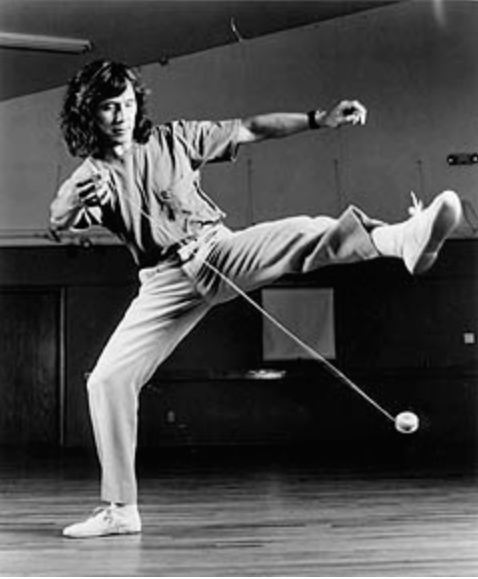
“Childhood Secrets” by Mel Wong, ph Kevin Bubriski
Wong was also a beloved teacher across the country and in Hong Kong.
Early Life
A fourth-generation Chinese American, Wong was born in Oakland Chinatown. But when he was five, his family moved to an all white neighborhood in Oakland. It was there that he became aware of differences, even as his parents wanted him to “become an American.” According to his widow, dancer/writer Connie Kreemer, he took gymnastics to shore up his strength to fight the white boys who teased him. And he studied ballet to improve his floor exercises in gymnastics. He joined the Oakland Civic Ballet, then Pacifica Ballet Company, and he also studied with Eugene Loring, Mia Slavenska, Carmelita Maracci, Anna Halprin, and at the Shawl Anderson Dance Center.
He took up the yoyo because he could practice alone with no one bothering him. In high school he won a local competition, beating out the football hero and winning a Schwinn bicycle—his first source of pride.
In New York he studied at the ballet schools of Richard Thomas/Barbara Fallis, Leon Danielian, and Robert Joffrey.
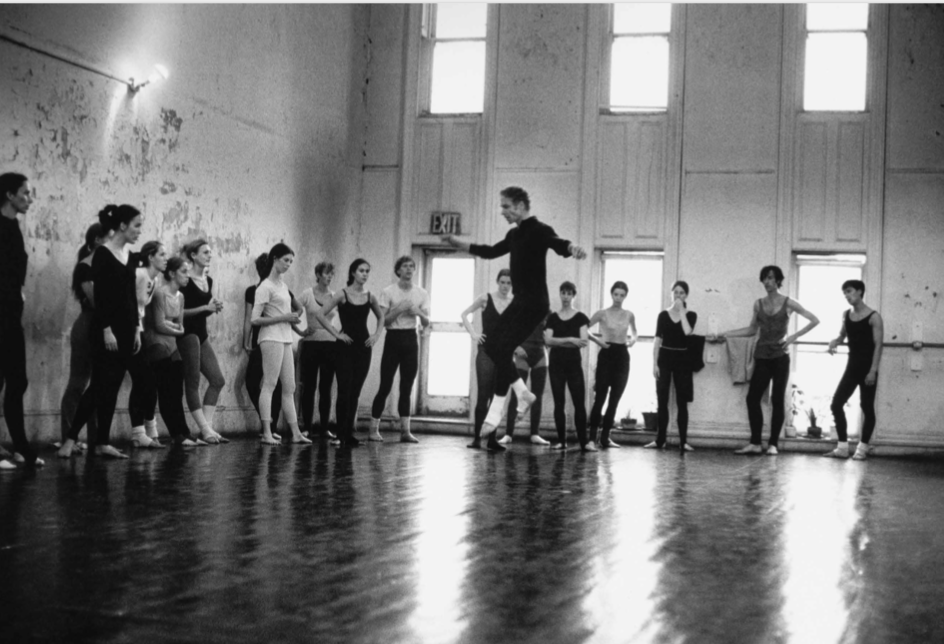
Class at Cunningham Studio, 1969. Merce jumping, Mel at far right, Sandra Neels in white, ph James Klosty
In 1964 he won a Ford scholarship to the School of American Ballet, the academy affiliated with New York City Ballet. Rumor has it that when ballerina Allegra Kent saw his bounding leap, she proclaimed he would be the next Nijinsky. (Reached by phone, Kent said the remark sounds like her, but she could neither verify nor deny she said it.) He attended San Francisco State University and then Mills College for an MFA in visual art. At UCLA, he worked toward an MFA in dance, but before he could complete the program, he received a telegram from Merce Cunningham (who had seen him in a master class) inviting him to join the company for a South American tour. He thought it was a joke, so he didn’t respond for a few days. For Mel’s farewell dance to UCLA, he arranged for a van with a mattress so he could leap out the dance studio window, Nijinsky-style, never to return again.
Dancing with Merce
Like all Cunningham dancers, Wong moved big. When you watched him, you didn’t think about his training. It all looked so natural. During his four years in the company (1968–72)—an exciting period in terms of Cunningham’s collaborations—he was part of the creation of Canfield, Tread, Second Hand, Signals, and the made-for-TV Assemblage. He also danced in Events, which were collages of existing pieces. The Events provided the bracing challenge of not knowing the order until the last minute. Wong would write the sequence on his palm, but the ink would drip away with the sweat.
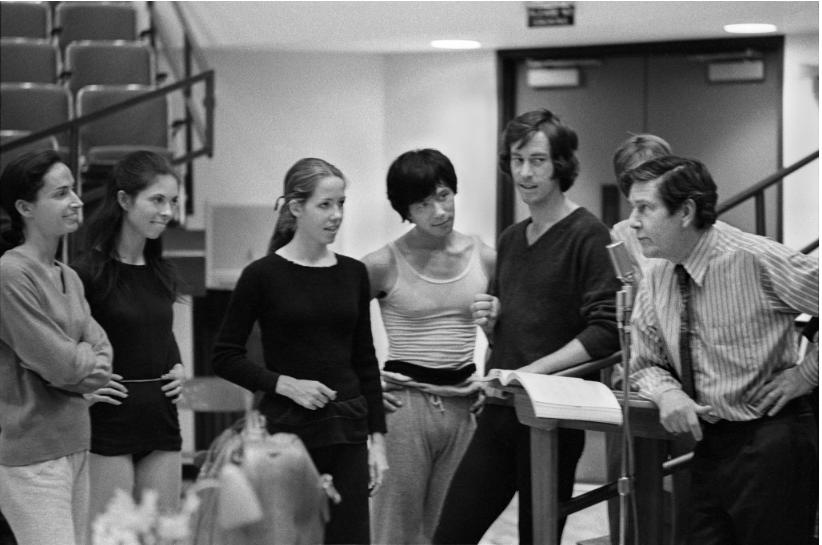
Cunningham company, l-r: Carolyn Brown, Sandra Neels, Susana Hayman-Chaffey, Wong, Chase Robinson, John Cage, ph. James Klosty
According to fellow dancer Sandra Neels, “Mel was great to have in the company because he was always very calm and in a good mood.” But he needed work on rhythm and timing, especially in partnering. So he would work on his own, dancing with a metronome to build up speed. Still, partnering was not his forte. He told Kreemer about performing in Rainforest, for which, as usual, the dancers didn’t encounter the set—in this case, Andy Warhol’s silver pillows—until the night of the performance. Another dancer had to leap into his arms, but at that moment a pillow was floating between them, and he had to think fast.
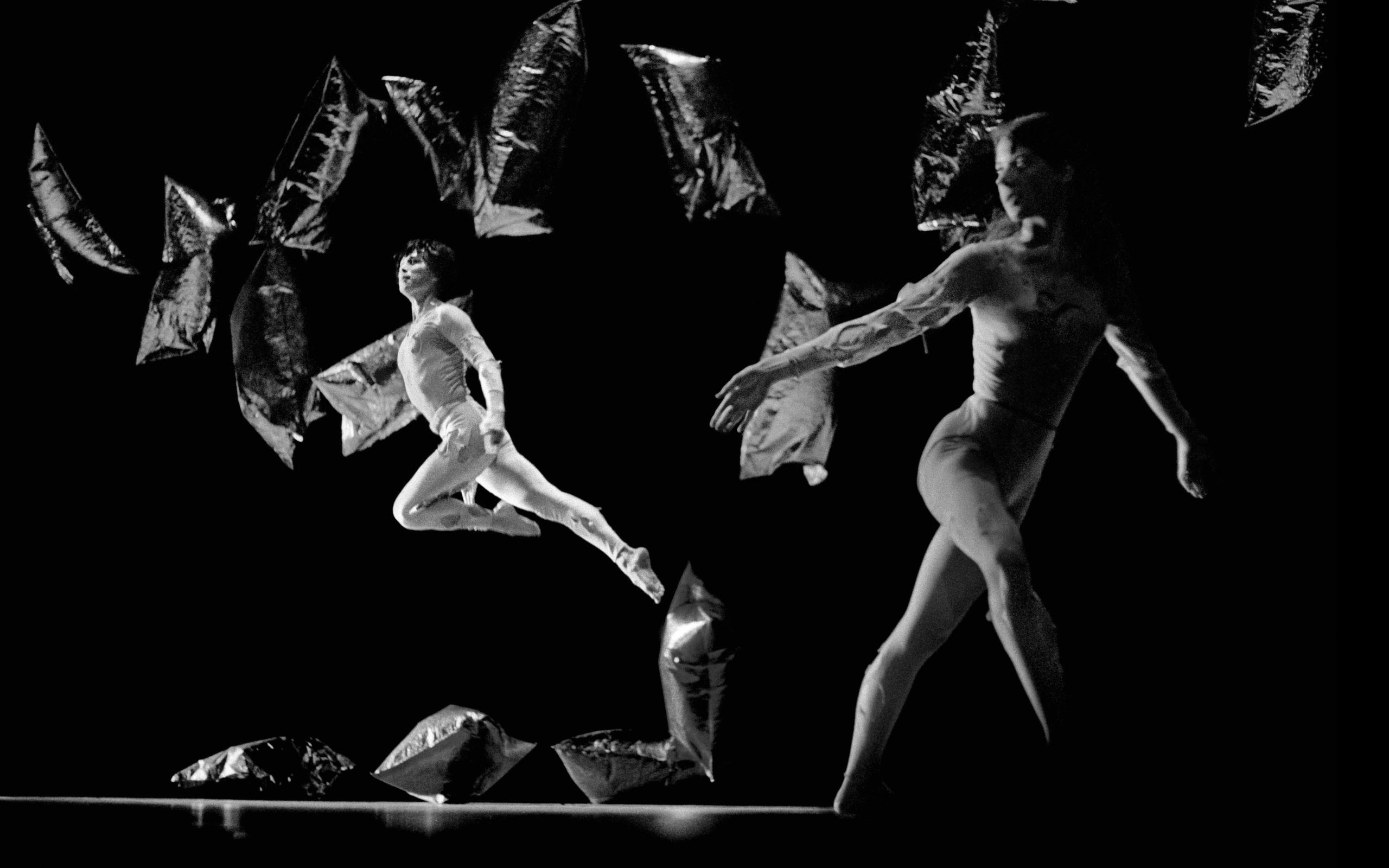
Rainforest by Merce Cunningham, decor by Andy Warhol, with Mel aloft, Meg Harper at right, ph James Klosty
In this clip from a panel discussion of Asian American dance artists at the University of Wisconsin at Madison in 1995, Wong expresses his admiration for Cunningham and Cage. In his relaxed, witty way, he also talks about what his Asian identity and spirituality mean to him as a choreographer.
Choreographic Process
While he was still in the company, in 1970, Wong started choreographing, performing in the streets, on the subway, or in front of the Statue of Liberty. In 1972, he staged a 12-hour work for Washington Square Methodist Church. It wasn’t until 1975 that he formed the Mel Wong Dance Company.
Dancer/choreographer Rosalind Newman, who worked with Wong in the mid 70s, described his process on the phone:
Mel could spill out a whole realm of movement. He never went back and edited. He would make it and then it would be made. The movement would fall out of him—action-oriented kind of movement. He was interested in the visual big picture, not very detailed. His sense of time was very different, more like a block of time rather than thinking of it like a melody. It didn’t have phrasing, and he would let me put that in myself. He allowed me the freedom to change the tempo inside of it . . .Being in his pieces always felt spacious and open. Even though they were choreographed, they still felt so open and free. And it was exciting physically: you had to just go for it. Afterwards, you felt like you just ran five miles.
Kreemer, who danced in many of her husband’s works, says his aim, while formulating movement, was “to clear his mind and get out of his own way and let the impulse take him.” When he transferred the movement to the dancers, he wanted them “to do the movement without thinking, to bypass the linear, verbal part.” She mentioned that he often had the dancers looking upward, up to the heavens. “It was connecting with the cosmos, connecting with the greater universe. He wanted people to connect with something greater than themselves. His dances were always about other realms, not just the typical world of the earth.”
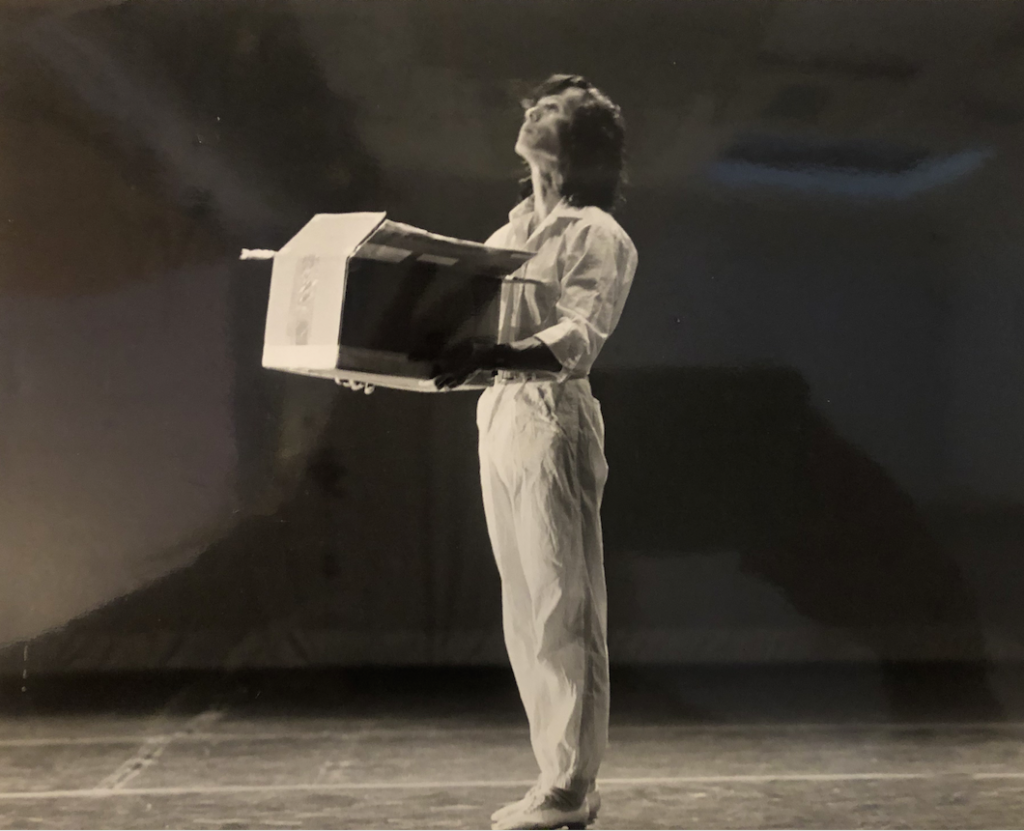
Undated photo
He loved the outdoors and would sometimes rehearse on a rooftop or, when he was living in Westbeth, the abandoned West Side Highway (which is now the High Line).
From 1979 to 1987, Wong collaborated with composer Rob Kaplan on more than 30 pieces. Kaplan was immediately taken with his choreography. “The first time I saw his work, I felt as I were watching a dream unfold. The images stayed with me for days.” But it took him a couple years to get into a groove of working with Wong. It was not a linear process but “an intuitive process that dealt with subconscious interaction.” The choreographer did not explain his choices. Kaplan later came to cherish what he called “the communal surrender” of the process. He described certain intense moments in the studio:
When Mel would choreograph, he would put both hands over his face, and just be still. You could hear a pin drop, and everyone was ready for whatever would happen next. He would point to somebody and Mel would move—quite an extended phrase—and then the person would do it.
Kaplan was sometimes involved in the visual aspects of making the work as well. “We’d go down to Canal Street and have a field day,” he recalled, speaking of all the stores in SoHo where you could buy hardware cheaply. Wong built plexiglass boxes and trays for a variety of pieces, recycling and varying his idea of what the boxes could hold. Often the trays held shallow pools of water. In one instance, a plexiglass box was filled with incense, and when a dancer lifted the lid off, smoke billowed out.
Wong’s process has influenced Kaplan’s own teaching at Arizona State University. “When I’m teaching dancers, I am basically helping them understand how to observe and listen and go with an impulse as opposed to intellect, to tap into different realms of your consciousness.”
Wong’s work changed over the years. With the growing influence of capoeira, he “excitedly tapped into his gymnastic champion roots,” Kreemer told me. “He experimented with using the floor, going upside-down, doing one-handed handstands and flips, going more and more off the axis.”
Images of experimentation
Wong made short dance-y pieces, large, unrepeatable happenings, and full-evening works. He often combined and re-combined his ideas, objects, images, and ideas. Here are some other snapshots, the first from my own memory, the rest from other sources.
• I saw Wong perform Ramp Walk in 1971 at The Cubiculo in midtown Manhattan. The simplicity of it was staggering to me. He simply walked up a 45-degree ramp that was nine feet high, carrying a heavy brick in his arms. You could see the weight of the brick affect him the higher he got up on that incline. Much later, I could look back and place Ramp Walk in line with Anna Halprin’s task dances and Simone Forti’s Slant Board. (I note here that both Halprin and Forti were also influenced by Asian ideas.)
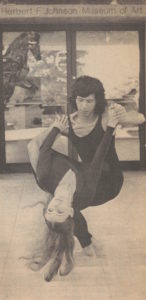
Wong and Renée Wadleigh rehearsing Catalogue 34 at Cornell’s Herbert F. Johnson Museum
• The multi-media Catalogue 34 (1973) occupied three galleries at Cornell University’s Herbert F. Johnson Museum, overlooking Cayuga Lake. There was music by Gordon Mumma and Pauline Oliveros and videos and paintings. The local reviewer (Ellen Beth Laipson in the Cornell Daily Sun) called it “a stunning presentation of Mel Wong’s world, a symbolic and dynamic dance ritual.” She mentions “the boundless energy of Wong’s vision” and “a spectacular ramp dance by Stephen Buck and Mel Wong” which must have been a duet version of the above. “Of special merit,” Laipson adds, “were Renee Wadleigh’s ‘Reflection’ solo, Roz Newman’s ‘Beginning,’ and ‘Walk in Water,’ with Wong and Wadleigh wading through plexiglass pools.”
• In Breath (1976), at St. Peter’s Church, dancers transferred goldfish from a bucket to a tank, Mel did tumbling tricks, and dancers read books on the sidelines. Also, a dancer breathed on a pane of glass, fogging it up, and then passed it on to the next dancer. This is the piece that caused Jowitt called Wong “a spiritual thinker.”
• He experimented with making some of the dancing not visible. In Peaks (1979), at the Cunningham studio, he built a low mountain in front of the dancers, and for SALT (1979) he built a dividing wall on wheels that would conceal some of the action. He also made drawings in a booklet with instructions for the audience on how to follow the dancing.
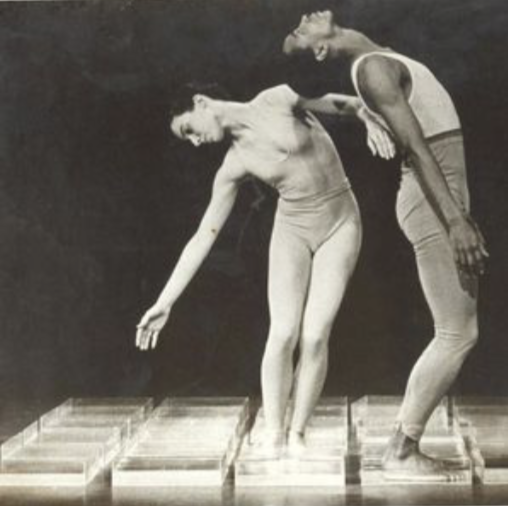
Streams, with Grazia Della-Terza and Henry Huey (a later, non-nude version),
• In Streams (1980), three dancers stepped in and out of 30 trays of water. For the soundscape, Kaplan scraped the inside of a piano with a wooden mallet. Three dancers, who were nude in the premiere, placed small stones in the water, making it ripple. The light reflected the water, giving off what Kreemer described as an “ethereal glow.”
• He tried different views for the audience. In Glass (1976) he strung paper up between the performers and audience, while the audience could see them only via video. Toward the end, three children slowly ripped the paper to reveal the performers. For A Town in Three Parts (1975), Wong placed the audience high above the dancers in the cavernous Cathedral St. John the Divine, and they could come and go, upstairs and downstairs, throughout the eight-hour performance.
• For Blue Mesa (1987), Wong collaborated with T.W. Timreck, who filmed scenes of the dancers in the Painted Desert. Kaplan recorded R. Carlos Nakai playing Navajo flutes and, for the film, recorded Skip LaPlante playing a metal pipe flute. Kaplan felt that Wong was making “a symbolic connection between the natural and human-made world, the ancient and the new.” Jennifer Dunning, writing in The New York Times, felt the piece was evocative:
Mr. Wong creates the feeling of dance in a time and space as untroubled, for the most part, as the surface of still water…. A central figure moves through the piece as an archetypal American Indian, at one moment a bird, at other moments a ritualistic water bearer and figure of death and rebirth. And as he moves, he seems to draw forces of nature in around him, as other dancers, … join in this ritualistic evocation.
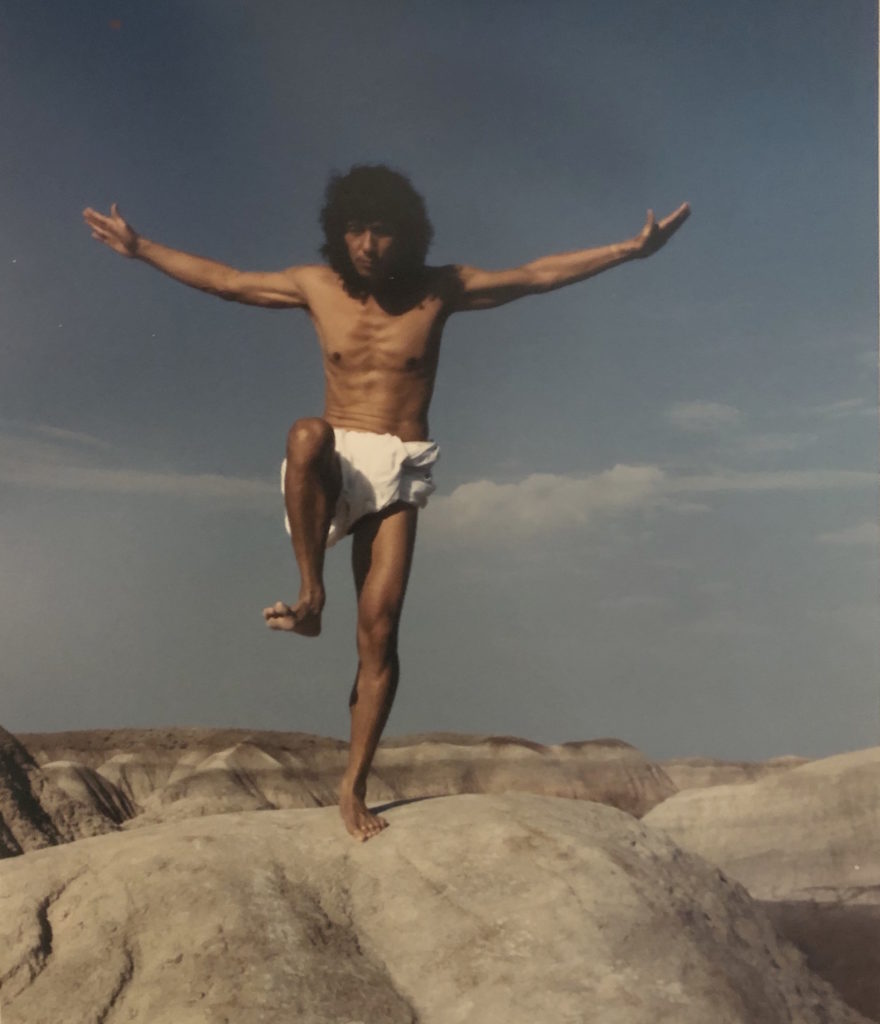
Wong filmed in Painted Desert for Blue Mesa, ph Connie Kreemer
• Falling Sky Event (1990) was an outdoor piece with five skydivers, 30 dancers, a trapeze artist, projection, motorcycles and tree climbers, at Artsfest, University of Colorado, Boulder. Wong made choreographic use of the steps of the university’s dance building, the tall windows, and the campus quad.
Asian influence
In 1983 Wong received a Guggenheim fellowship to travel to Hong Kong and China. In her book Further Steps 2: Fourteen Choreographers on What’s the R.A.G.E. in Modern Dance, Kreemer wrote that “it was the first time he’d been in a country where he was in the majority race, where people looked like him…and he felt at home. He became more conscious and proud of the beauty within Chinese culture.”
Rob Kaplan accompanied Wong and Kreemer on that trip, and they created a concert for the modern dance company in Hong Kong and performed in the Asian Arts Festival. The trip deepened what Kaplan called Wong’s “ancestral knowledge.” He became more committed to the symbols of Chinese culture: water, rock, mountain. (See Appendix II for Mel’s list of symbols.)
In terms of the musical collaboration, Kaplan points out that he and Wong often worked in an area of overlap between an Asian sense of time and minimalism: “We allowed time to play out with single sounds while the movement provided the ‘melody.’ The use of drone sounds and repetitive patterns—these were also very much part of the ‘minimalist’ vocabulary.”
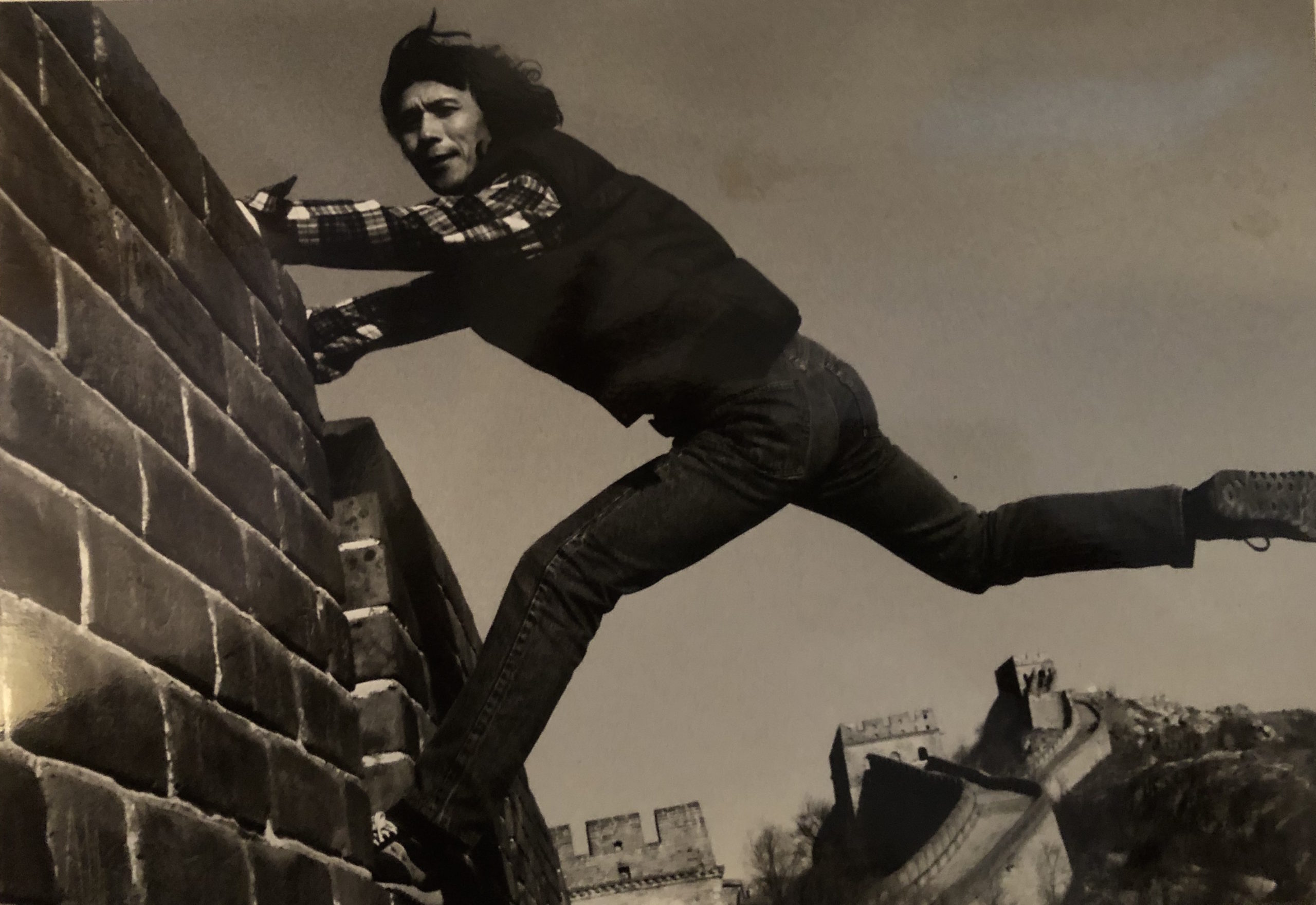
At the Great Wall of China, c. 1983, ph Kreemer
Other Story-telling Solos
When dance artist and educator Li Chiao-Ping saw Wong perform his yoyo solo, she recognized similarities in their lives as American-born Chinese. As she said, “There’s so much pressure in the family to do something else” besides dancing. She was also overwhelmed by his virtuosity. “He had such control. The overall impression took my breath away. Here was this Chinese American man who was so good at so many things and was so contemporary.”
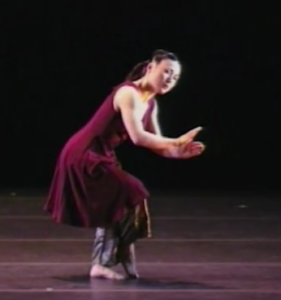
Li Chiao-Ping in Judgment by Mel Wong, ph screen grab
In 1997, Li asked Wong to be one of six choreographers for her solo program at University of Wisconsin, Madison. He decided to use their common backgrounds to create the text for a dance called Judgment.
At first, Li was not prepared for Mel’s dive-in mode of making: “He’d walk to the spot and whip out the movement. I’d look at him like, ‘What just happened?’ ” But she quickly adapted. As she took part in his process, she perceived a melding of East and West:
He had a vast skill set of using postmodern tools that gave him a kind of freedom. As much as he didn’t prepare, he was following something, a flow. Maybe he learned almost a Zen approach in making the work. Attention to craft, but open to chance and aleatory operations, letting spontaneity take place as well.
Click here to see an excerpt of Judgment, interspersed with Wong’s explanations.
Wong also made three solos for Kreemer. In one of them, Never Say Never, she talked about their efforts seeking fertility and how it was a Chinese barefoot doctor, prescribing dense balls of Chinese herbs, who solved their problem. (They eventually had three daughters.)
Another solo, this one part of a larger work, was for Beth Soll, the summer of 1974 at Harvard Summer School Dance Center. It didn’t tell a story to the audience, but it told the story of their friendship that summer. Beth had come down with a severe flu, and he made a dance that fit her fragility at that time:
I was very weak and could barely walk. He took me out every day to eat. “Eat, Beth Eat.” I would go to rehearsal and lie on a bench. He made a tai chi dance for me. The spiritual thing was like breathing for him. I love doing something slow and peaceful onstage. Other dancers poured water into buckets. Making this part for me was an act of generosity. In a sense he cured me.
He also made purely musical solos. Silvia Martins, a freelance dancer who toured her own solo program, accrued 11 dances by Wong. His Bolero for her garnered a praise from critic Tobi Tobias, who called the dance “marvelous” and the rhythms “unpredictable and arresting.”
Teaching
Kreemer came to Wong’s classes as a dancer with Erick Hawkins and Nancy Meehan. “Mel would show a phrase not more than twice and you’d have to immediately repeat it on the second side. My friends who were trained in Hawkins would leave his class in tears.”
But most people felt challenged by his classes. Beth Soll, who taught at MIT for 20 years, said “I brought him to MIT and students adored him. He would demonstrate fantastically difficult combinations and the students just had to keet up.”
The freelance dance artist David Thomson studied with Wong at SUNY Purchase in the ’80s. In a recent phone conversation, he said, “Mel felt more approachable to me than other teachers, more easy-going and open about what dance was or could be. Being one of the few people of color on the faculty and working in a postmodern aesthetic was a rare gift to experience during my formative years there.” One of the things students were charmed by was that he always wore white sneakers to teach class. (“No one at Purchase ever saw Mel’s bare feet.”) But the main thing, as Thomson said, was that “Everyone, everyone, everyone loved him! He was a phenomenal teacher.” Naturally, the students were upset when Wong was denied tenure, and they mounted “a bit of a protest.”
Wong was invited to teach at the Hong Kong Academy of Performing Arts in ’87 and’88. Rosalind Newman said that people there, even now, in 2020, still talk about him. “He made a big impact. The physicality of his classes affected the way they think about dancing. You come in and whack it out. Just do it. In just doing it, you do things you never thought you could do.”
Wong also taught at Cornell, Trinity College in Connecticut, Arizona State University, the University of Colorado at Boulder, and independent classes in SoHo. His final teaching gig was at UC Santa Cruz, where he was full-time professor in the Theater Arts Department from 1989 till his passing.
Critical and Funding Response
Wong received a Guggenheim fellowship, six National Endowment for the Arts fellowships, a grant from the Foundation for Contemporary Performing Arts, and many commissions. But funding was not consistent. At least once, when applying for a special grant for artists of color, he was told that his work wasn’t “Chinese enough.”
Although he was sometimes reviewed favorably, many critics often expressed mild disdain when greeted with his work. Jack Anderson, writing for The New York Times in 1982, called his work Shuttle, in which dancers transported paper stars and moons, “mystifying at best, pretentious at worst.”
From Wong’s point of view, critics and funders did not make the effort to get past cultural barriers:
I remember a remark from a panelist who said I was “putting them on.” I was very upset and mad…I worked all year long, saved my money to produce my dance concerts, and would spend over $10,000 on a dance concert, which would be over in three or four nights . . . I was very bitter but I continued to make dances despite the criticism. I had support from the dance community, my concerts were always sold out, and besides, I loved to make dances.
Another factor that could have chilled the critics’ reception is that, for many years, Wong did not edit his dances. Even Kreemer says many of his pieces were too long and she tried to convince him to tighten them.
Nevertheless, the performers were often praised. About Renée Wadleigh in Four or Five Hours with Her, Cornell critic Barbara Jasperon wrote, “It was impossible to dismiss Renée Wadleigh’s presence, her control, exhaustive, and desperately beautiful dancing or the intentionally emotional evocations of the piece as a whole.”
Wong as a Visual Artist
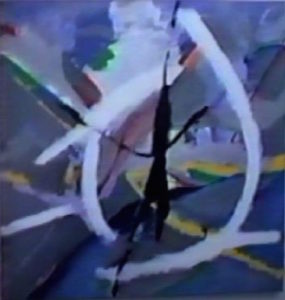
A painting by Wong, 1990s
Wong was also a painter, and he infused his dances with his artistic sensibility. Drawing was an artistic compass for him. “He might have an idea about something,” Kreemer recalled, “and he would just start drawing or painting and let it flow out of him.” Sometimes he showed his art work in the lobby of the theater because he felt they related to, or came from the same impulse as, his choreography. Sometimes he would create sets for his work, like a small mountain. Other times, even without sets or props, his spatial sensibility was keenly felt. As Dunning wrote in 1985, “Mr. Wong has a clear and vital sense of spatial arrangement, and he clustered bodies arrestingly at times.”
Wong was fascinated by light. Kreemer describes a section of Buddha Meets Einstein at the Great Wall (1985), where Mel was wearing all white. “He would enter the stage from the diagonal, carrying a cardboard box, and leave and return many times. Toward the end, he knelt down and opened the box and there was light emanating from the box. Then he started his solo.” That solo, judging from this clip, was ghostly and prayerful.
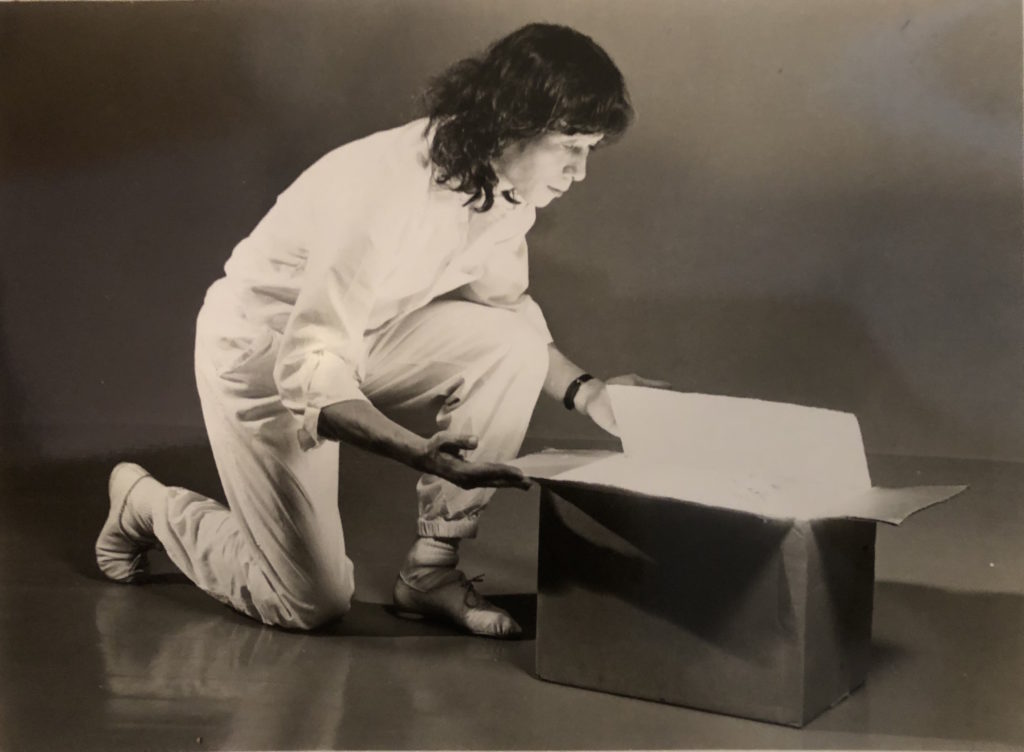
Wong with light box, ph Johan Elbers
Mel Wong was the first Chinese American to win a Guggenheim fellowship in dance and the first Chinese American to perform with Merce Cunningham. He was among the first Asian students at SAB. But no one was keeping track back then. According to Kreemer, “Mel had a lot to say about racism, and his Growing Up Asian American in the 50s series was a way of releasing anger and letting people know, in his own humorous, educational way, how racism had wounded him as a child and how he continued to feel its effects.”
For a subsequent solo in the series Growing Up Asian American in the 50s, he wrote this:
I was told to keep my silence but after fifty years, I must speak out! The Naturalization Act of 1790 stated that citizenship was reserved only for whites. That law remained in effect until 1952. The Chinese Exclusion Act of 1882 was directed at the Chinese on a racial basis.
As always, there is dancing. In the documentary on Li Chiao-Ping’s solo project, Wong says the following:
You dance before you go to war. You dance before you get married. You dance at a funeral. And so dance really is a powerful form, and I still don’t quite understand why it’s not as respected as other art forms. It’s the juxtapositioning of everything in the world, that makes the world go.
¶¶¶
Special thanks to Connie Kreemer, Rob Kaplan, Doug Rosenberg, Rosalind Newman, Li Chiao-Ping, Beth Soll, Sandra Neels, Renée Wadleigh, James Klosty, Kevin Bubriski, Nick Perron-Siegel, Stephan Koplowitz, and Andrea Potochniak of the Herbert F. Johnson Museum of Art at Cornell University. Other sources include a chronology of choreography.
Appendix I
Below is the monolog [with names of yoyo tricks in brackets] of “Childhood Secrets,” Mel’s solo from his series, Growing Up Asian American in the 50s.
I was born in Oakland, California [Rock the Cradle]. I grew up in an all-Chinese neighborhood [The Sleeper]. We lived in a big white house. We lived on the first floor [Around the Corner]. I lived with my mother, my father, my brother, my grandmother, my aunt, and my uncle [Loop-de-loop]. My grandmother took care of me most of the time, when I was very young. My parents were busy working, making money [Three-leaf Clover, Three-leaf Clover]. I remember my grandmother would cook Chinese food, three times a day: breakfast, lunch, and dinner. And sometimes, she would cook spaghetti [Spaghetti]. I remember she would cover the big, round table with newspaper, and use that as a tablecloth. And one day, the newspapers were gone, and replaced with a plastic tablecloth. I wondered why. And then I heard my parents talking to my grandmother, saying, “We’re not going to use newspapers anymore,” they’re gonna do it the sanitary way, the modern way, the western way. A few days later, I saw pictures of a Chinese family, eating their meals using newspapers as tablecloths. And I can’t help but to think: they were making fun of us [The Creeper].
Recently, my wife was pregnant. And we had to drive from Boulder, Colorado, to Santa Cruz, California. She was due in two weeks. So, I asked the nurse for some emergency information. I said, “What should we do if she delivers out on the highway?” The nurse said, “Bring a lot of newspapers. For newspapers are the cleanest and most sanitary thing you can find around the house” [Around the World] [Brain Twister] [Man on a Flying Trapeze].
At the age of five, we moved to an all-white neighborhood. And for the first time, and for the first time, I realized… I was different. I used to go with my parents to look for a new house. They would always come back, with their head bowed low, and say nothing. And one day, my father said, “They don’t sell houses to Chinese people.” Eventually we did find a house—a beautiful house, next to a lake. When we got settled, my father took me to the neighborhood barber for a haircut. The barber said, “I don’t cut Chinese people’s hair.” So, my father promptly took me back to Chinatown. Or, my best friend in grammar school has me to his house to play. His mother said, “Where did you find this little boy? You can’t play with him—he’s from the west side.” Or, if you ask people from my generation when they learned how to swim, they’ll tell you, “In the late teens,” because in those days, they did not allow minorities in the public swimming pool.
Time has moved on, and many things have changed, and yet many things have not changed. I look up in the sky, and I see the Big Dipper. I look up in the sky, and I see stars shining brightly [Star]. I look up into the sky, and I see shooting stars, shooting up into the heavens [Shooting Star]. And I still believe that people will understand each other, and that love will prevail.
Yoyo solo, ph Johan Elbers
Appendix II
Kreemer found Mel’s handwritten list of symbols, which was based on A Dictionary of Symbols by J.E. Cirlot, the original 1962 printing by Philosophical Library. Because the handwriting did not reproduce well, I’ve typed the correspondences here:
Crescent moon — world of changing forms, also, medieval emblems of the Western world
Flame — transcendence itself – light signifies the effect of transcendence on
environment
Mirror — symbol of imagination/reflect the formal reality of the visible world
Mountain — for the Chinese. greatness of generosity of emperor. Profoundest symbolism is one that imparts sacred character.
Stone — cohesion and harmonious reconciliation with self, unity and strength, rock permanence
Water — Chinese consider water as the specific abode of the dragon because life comes from H2O
Star — ascension toward spirit, forces of spirit struggling against forces of darkness
Lighting — spiritual illumination
Smoke — escape from time and space into eternal
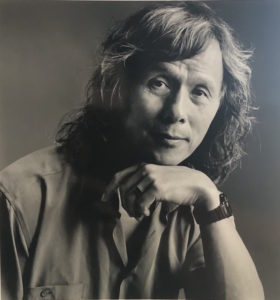
Portrait by Paul Schraub
Uncategorized Unsung Heroes of Dance History 9
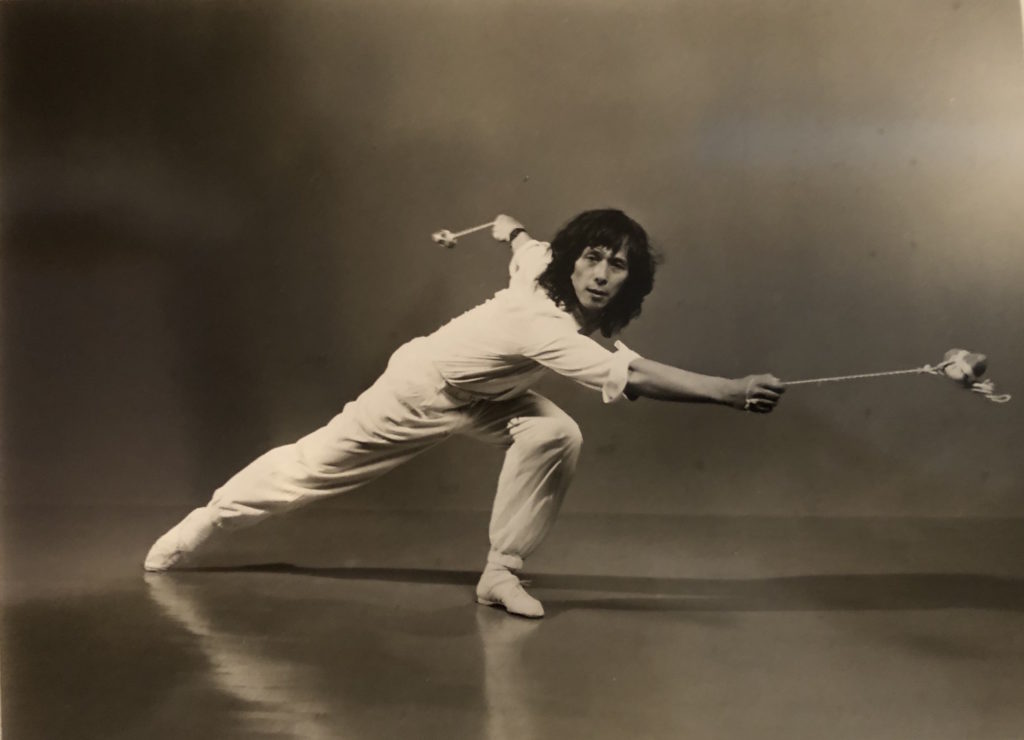
Thank you for this wonderful piece–I learned a lot about Mel’s work! He was one of my favorite dance teachers in the 1980s when he was visiting different studios in SF and NY. Of course I remember his white sneakers, the sun salutation, and the challenge of his combinations. I loved his movement quality which was an unusual combination of specific lines and shapes influenced by his Cunningham experience combined with a dynamic free flow. The movement at times seemed casual and tossed off, thrown and released, and yet it was complex and precise. It was deeply satisfying movement to dance because it was both challenging and rewarding. Thank you for bringing back those memories and teaching me more about his wonderful work.
It’s wonderful to see these pictures and have Mel’s story told so eloquently. Mel Wong had an impact on so many people during his life.
To supplement the story Wendy tells, here is a link to the sound score to the 1980 piece, Streams. As mentioned in the article, it was created by recording scraping a wooden mallet on piano strings. But each sound had the attacks edited out to create a gentler, shimmering sound.
https://soundcloud.com/robkaplan/strms_cleannfixed_nrmlzd
~Rob Kaplan
Thank you Wendy, for this beautiful tribute and overview of Mel’s work. I took Mel’s improvisational forms class almost every semester at SUNY Purchase in the late 70s-early 80s. Watching the video clip brought me back to the calming and invigorating way he taught. I was so frenetic then, so hearing someone talk the way he did was my first intro to anything like meditation and spirituality. The innovations and risks he encouraged and the nonjudgmental message he shared spoke to me directly, particularly since I was often the only overweight dancer in the room. I was heartbroken when I learned a few years ago of his passing. What a legacy he shared with young people and those who got to see his dances. I would love to see that entire yoyo dance!
I just realized that I inserted the wrong video in the beginning of the Appendix. OK, I fixed that link, and now, if you click on Childhood Secrets, you’ll see the whole yoyo dance.
Oh my goodness Wendy, thank you so much for posting the full version of the yoyo dance. So extraordinary to see this performance, especially after reading the transcript from it that you provided. I learned about your article through a Facebook page from SUNY Purchase for students who were there mostly in the 70s and some later. Your article has inspired beautiful memories and tributes from many of Mel’s former students. Thank you again.
Mel was extraordinary. I have a catch in my throat reading this profile and Wendy’s capture of a wonderful artist whose sensibility and work was important to me at the moment I discovered dance. Wendy, your work in bringing these artists back to us in this moment is so important. How I loved that time dancing in Mel’s classes! There was so much that I witnessed as ‘found’ in his work, beginning in the body but also in its site and relationship. What a beautiful man, his dance was beautiful, about pleasure and about possibility.
My friend Barbara danced with him but this is the first time I have seen him dance. That Buddha/Einstein solo is magnificently glorious! He is both ethereal and grounded alternately and simultaneously. I want to see the whole dance.
Thank you for doing this series. Your writings are assisting me in catching up on what I missed.
Thank you so much for this piece, Wendy! Oh I realize there not many scholarship on Mel yet! And he works for Cunningham, which aligns with my research topic Performing Objects!! I am so excited to find this piece, I think I will write on his work later!!
Glad you like it. I am actually doing more research on Mel cuz he will be a chapter in my book. Yes, he performed with many Objects, always with a hybrid East/West sensibility.